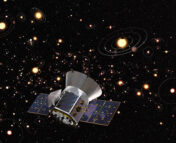Authors: Jason T. Wright, Jacob Haqq-Misra, Adam Frank, Ravi Kopparapu, Manasvi Lingam, and Sofia Z. Sheikh
First Author’s Institution: 525 Davey Laboratory, The Pennsylvania State University, University Park, PA, 16802, USA
Status: Published in ApJ Letters [open access]
The first author of this paper also published a series of blog posts on this topic – check them out at this link!
“Who else is out there?” is a question that has been asked throughout the eons of human history. While our ancestors had only their imagination when they first pondered this question, today’s astronomers and astrobiologists look to other worlds in hopes of finding biosignatures – markers that provide scientific evidence for the existence of life. Biosignatures come in many forms, such as gas in a planet’s atmosphere that can only be produced by living organisms, organic matter, or fossil records. An extension of biosignatures are called technosignatures, signs of technology developed by intelligent life, such as the radio signal in the movie Contact or the multitude of space probes drifting around the Solar System. Which of these are more prevalent in the cosmos? While finding biosignatures may seem more likely (we’ve had more success finding and characterizing exoplanet atmospheres than Dyson Spheres after all), the authors of today’s paper argue that looking for technosignatures might actually give us equal, if not better, chances of finding life.
Here Be Dragons
Astronomers have put a lot of effort into searching for bio- and technosignatures – from the founding of the SETI Institute in the 80’s to the more recent Breakthrough Listen project – and they also have different expectations for how abundant these signatures are in the universe. One of the most famous ideas for expressing an estimate for the number of intelligent, communicative civilizations in the Milky Way (MW) is the Drake Equation. The authors use this framework to construct two Drake-like equations representing the number of planets with detectable bio- and technosignatures: N(bio) = R* fp np fl Lb and N(tech) = R* fp np fl ft Lt. The first four factors in these equations are the same. R* is the MW’s star-formation rate, fp is the fraction of stars that harbor planets, np is the number of habitable planets per star and fl is the fraction of habitable planets that could develop biospheres and emit detectable biosignatures. The technosignature equation also includes the extra term ft, which is the fraction of planets that have not only life, but detectable technosignatures. Lb and Lt are the length of time that species sends out detectable bio- and technosignatures, respectively.
Comparing these two equations, it seems at first glance that technosignatures should be infinitely less ubiquitous than biosignatures, if we assume that the rise of technology in a civilization is 1) an extremely rare occurrence that 2) only occurs for a short period of time compared to the lifetime of the civilization. But the authors of today’s paper argue that these assumptions are flawed because they presume, by definition, that technology is inseparably tied to biology in both time and space–one can’t exist without the other. By examining technosignatures from four different perspectives–abundance, longevity, detectability, and ambiguity– they show us the power of searching for alien signals in the sky.
“There isn’t enough life on this ice cube to fill a space cruiser”
The first metric they grapple with is abundance. Though Earth itself does host a significant fraction of communicative technology, our next door neighbors – Venus, Mars, and Jupiter – also have their own probes and/or rovers we sent from Earth continually updating us (and the rest of the universe) about their surface and atmospheric conditions without scientists ever needing to get up from their couches. So it’s not out of this world to think that in a few hundreds or thousands of years, humanity could set up remotely controlled technological bases on other planets or moons, operations that don’t require the presence of organic life to coexist in the same location. And as we become more savvy with space technology, the probes we send out could spread farther and farther like dandelion spores: one planetary base creates a hundred new probes, which then replicate and spread to create other bases and birth hundreds of more probes, eventually spreading beyond our solar system–thousands of Voyagers inhabiting nearby star systems. And while we can currently only dream of sending actual astronauts out to other solar systems, science fiction technology like cryostasis and artificially grown DNA are not scientifically implausible, and when we are finally able to settle a new world, we will most definitely create technosignatures and possibly a new biosphere that can continue the spreading process anew.
“Difficult to see; always in motion is the future”
While technology might be able to spread far and wide, it certainly doesn’t “live fast and die young” – the longevity of these signals may far exceed our own. While past and present issues of global warming, nuclear catastrophe, and a pandemic-ridden planet make it easy to be pessimistic about humanity’s future hundreds of years from now, there’s no reason that other species on other planets couldn’t evolve very differently. The authors caution that we should put anthropocentrism aside and shouldn’t judge the possible longevity of other species’ technosignatures based on our own.
And even if we do use humanity as a guide to technosignature longevity, unless we cause our complete extinction, we can always rebuild and remaster our technological prowess. After all, we did it once, so there’s no reason to think we wouldn’t be able to do so again. If not us, then it is possible that another species will evolve after thousands of years and take up the technological niche that we left behind. And though technology might be a potential cause of humanity’s downfall, if we don’t let Don’t Look Up serve as an example, it can also be a life ring to let us prevent disaster from, say, an asteroid hurtling towards our planet.
The authors also point out that though we might assume that all technological progress on Earth has been made in the last few centuries, if there were aliens observing Earth a million years later, they would see definite changes to our geological history during the Anthropocene era, but they wouldn’t be able to tell that these changes are technologically-driven. Therefore, if Earth previously had technological life, we wouldn’t be able to tell! And compared to our frail selves, technology can be much more resilient, surviving in the cold, harsh barrenness of outer space. If all of humanity died tomorrow, all our satellites, spacecraft, probes, and rovers would still continue transmitting data for some time after we were gone. Our own technology is a legacy that can outlive us over very long timescales, telling other species that “Humans were here”.
“That’s no moon…it’s a space station!”
The last two facets of technosignature metrics are detectability and ambiguity. The authors make the point that the technosignatures we send out right now are equal in strength to our own biosignatures. In fact, with our current technology, we wouldn’t even be able to detect our own biosignatures if we were on Proxima Centauri, our nearest stellar neighbor! Meanwhile, some of our largest telescope arrays are very close to the point of being able to detect our emitted radar signals if they were placed as far as a few parsecs away from Earth. Technosignatures can be orders of magnitude stronger than biosignatures, in theory even harnessing the entire power of the galaxy.
And though sometimes someone microwaving a burrito could lead scientists to erroneously believe they’ve uncovered a signal from the stars, assuming we account for human errors, there are many technosignatures that are completely unambiguous. The authors bring up the example of a narrowband radio signal–as far as we know, there is no living organism that could possibly emit such a signature. Meanwhile, biosignatures are a little more tricky. You might remember about a year ago when scientists announced that they had discovered phosphine in Venus’s atmosphere, which can be produced from bacteria’s metabolic processes. Not only can phosphine be produced by other sources such as volcanic eruptions, the authors of the original paper made a mistake, sounding a false alarm. All data that we take has a risk of being interpreted incorrectly, whether it’s a bio- or technosignature, and so the authors recommend that astronomers should look for multiple different signatures rather than rely on one sole observation.
The bottom line is that while life is the initial impetus for the creation of technology and technosignatures, technology can live a life of its own far from the biosphere it was born in. Both signatures have different limitations and evolutionary paths, and neither is superior to the other. The authors recommend that scientists point their efforts towards searching for both bio- and technosignatures in order to give ourselves the best possible chances at finally learning who else might be out there, maybe also pointing their own telescopes towards Earth.
Astrobite edited by Evan Lewis




